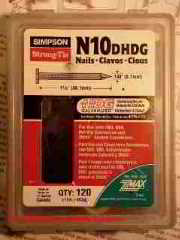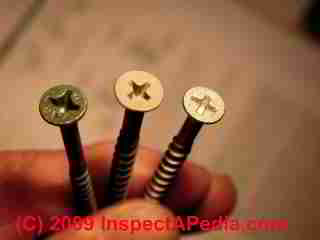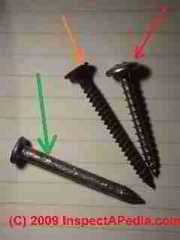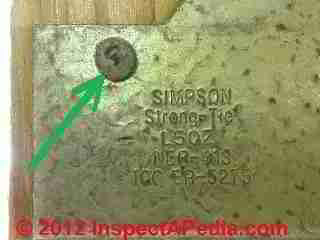 Deck Fasteners: choices, uses, tips
Deck Fasteners: choices, uses, tips
Deck Design-Build Online Guide
- POST a QUESTION or COMMENT about deck construction
Deck Fasteners
This article series describes critical safe-construction details for decks and porches, including avoiding deck or porch collapse and unsafe deck stairs and railings.
InspectAPedia tolerates no conflicts of interest. We have no relationship with advertisers, products, or services discussed at this website.
Deck Fasteners for Construction, Structural Connections, Deck Board Installation

Even the best-quality fasteners account for only a small portion of the cost of a new deck, and they are well worth that modest investment. When choosing fasteners, pay close attention to their holding capacity and their corrosion resistance.
[Click to enlarge any image]
Fasteners that are too weak for the job or that corrodes prematurely can weaken an entire deck.
Stainless-steel screws, nails, and bolts cost considerably more than other fasteners, but they are the most resistant to corrosion. You should certainly choose stainless steel if you are building in an especially wet or salty environment. It is also recommended if you are using redwood or cedar.
Hot-dipped (HD) galvanized fasteners are more affordable than stainless steel and are suitable for most decks.
Electroplated fasteners are also galvanized, but their treatment differs from hot dipping, and they do not resist corrosion well. Fasteners that are coated by hot galvanizing (HG) are also inferior to HD galvanized fasteners.
Nails for Deck / Porch Construction
Nails with smooth shanks have the least amount of holding capacity. As the wood shrinks slightly over time, they will loosen and allow lumber joints to separate.
Ring-shank or spiral-groove nails, or screws, hold much better. Other nails serve special functions, such as securing joist hangers or light wood trim.
Screws for Deck / Porch Construction
 Screws are not available with a hot-dipped galvanized finish, but you should look either for stainless-steel screws or for galvanized screws that have been coated with a weatherproofing resin.
Screws are not available with a hot-dipped galvanized finish, but you should look either for stainless-steel screws or for galvanized screws that have been coated with a weatherproofing resin.
Screws with a yellow zinc coating offer less corrosion resistance. If you will be using a lot of screws, look for those that use a square drive bit. They are easier to drive, and the drive bits last longer than standard Phillips drive bits.
Watch out: do not use non-structural screws. The green arrow in the photo points to a proper nail for use in joist hangers and similar connectors. The orange arrow marks a drywall screw, not rated for construction use, and the red arrow marks an
"outdoor" galvanized screw but one whose box label clearly states not rated for construction use.
We found a deck whose contractor used the red-arrow-marked screws for all of the joist hangers. All of them had to be replaced.
Bolts for Deck / Porch Construction
Bolts are heavy duty fasteners intended to carry heavier loads than standard nails and screws. Carriage bolts and lag screws are used to connect ledgers, railing posts, and other critical deck framing members.
Carriage bolts, which require a nut, are usually stronger than lag screws, but cannot be used for very thick connections or if the back side of the fastener is not accessible. Both require pilot holes. Anchor bolts (or J-bolts) are used to secure posts to concrete piers. Use a washer with each type of bolt.
Hidden Fasteners for Deck / Porch Construction
Many people think that the visible heads of fasteners used to secure decking are an ugly presence, especially if they have paid for top-notch decking. In response to that concern, many hidden fasteners are now available. They cost more and take more time to install, but the results can be worth it.
Framing connectors for Deck / Porch Construction
 A variety of connectors are made specifically for connecting the various components of a deck; avoid regular, uncoated joist hangers, metal straps, and other connectors, which are not intended for exterior use.
A variety of connectors are made specifically for connecting the various components of a deck; avoid regular, uncoated joist hangers, metal straps, and other connectors, which are not intended for exterior use.
Electroplated connectors are fairly easy to find; hot-dipped galvanized and stainless-steel connectors may be harder to locate, but are worth the effort.
The photo at left shows a proper framing connector screw used in a Simpson Strong-Tie L50Z connector.
Selecting Other Materials for Deck / Porch Construction
Lumber and fasteners are the major materials used in building a deck, but they are not the only ones.
If you will be cutting into the siding of your house to install a ledger, you need to pay close attention to selecting materials that can prevent moisture from causing damage. In most cases, you will need concrete to help anchor the deck to the earth. And to protect the deck from premature aging, you should choose a top-quality finish and apply it regularly.
Deck Board Fasteners, Deck Clips & Hidden Fasteners
A variety of methods for securing deck boards to the deck joists are discussed separately
Moisture Barriers and Deck Framing
Several types of moisture barrier can be used for the area where the house and deck framing connect, although your building code may require a specific product. Metal flashing is available in aluminum, galvanized steel, copper, and stainless steel.
Preformed aluminum and galvanized flashing are inexpensive and easy to install. The style you are most likely to find is formed to slip behind the siding and over the top of the ledger, but better protection is provided by flashing that runs behind the ledger.
If you are unable to find preformed metal flashing suited to that type of installation, you can buy a roll of sheet metal and form one yourself. If you use aluminum flashing, and need to nail it, be sure to use aluminum nails; using galvanized steel nails encourages corrosion.
Another option is a flexible, self-adhering membrane. Although these products offer outstanding protection, they require a little more effort to install than metal flashings that can be slid up behind the siding
Concrete for deck or porch piers
You will need concrete to form foundation footings and piers, and you may need it to create a landing pad for stairs or a support slab for a hot tub.
If you are building a large deck, with many deep holes to fill, it is probably best to have ready-mixed concrete delivered by truck. Check with local suppliers for costs and minimum order requirements. For smaller decks, you can mix your own concrete.
Although dry concrete is a mixture of Portland cement, sand, and gravel, you are usually better off buying bags with the ingredients already combined. Add water as directed on the package.
For creating concrete piers, inexpensive cylindrical tubes are an excellent choice, and they may be required by your building code. The tubes are available in various diameters and can be cut to the necessary length with a handsaw.
Wood Finishes for Decks
The essential ingredients for deck longevity include thoughtful design, careful construction, and routine coatings with a good- quality finish. All wood decks perform better with routine finishing. And even if you are using composite decking and railings, you will need to apply a finish to the deck’s substructure.
Finishes are available in a variety of colors and formulations.
Choose the type of finish you will use when you design the deck. The best time to apply a finish is as soon as possible after the deck is built, so it is a good idea to buy your finish along with other deck materials.
...
Continue reading at FRAMING CONNECTORS & JOIST HANGERS or select a topic from the closely-related articles below, or see the complete ARTICLE INDEX.
Or see these
Recommended Articles
- CONNECTORS, FASTENERS, TIES
- DECK BUILDING & CARPENTRY TOOLS
- DECK FASTENER CHOICES
- DECK FRAMING TABLES, SPANS
- FRAMING AGE, SIZE, SPACING, TYPES - basics of building framing
- FRAMING DAMAGE, INSPECTION, REPAIR - home
- FRAMING FASTENERS, NAILS, SCREWS - best construction practices.
- FRAMING CONNECTORS & JOIST HANGERS - best construction practices.
- HURRICANE TIE DOWN CONNECTORS & FASTENERS - are screws ok to use instead of nails?
- STAIR STRINGER to FRAMING CONNECTORS
- TOE NAILED FRAMING CONNECTIONS - traditional framing without steel connectors
Suggested citation for this web page
DECK FASTENER CHOICES at InspectApedia.com - online encyclopedia of building & environmental inspection, testing, diagnosis, repair, & problem prevention advice.
Or see this
INDEX to RELATED ARTICLES: ARTICLE INDEX to BUILDING DECKS & PORCHES
Or use the SEARCH BOX found below to Ask a Question or Search InspectApedia
Or see
INDEX to RELATED ARTICLES: ARTICLE INDEX to BUILDING STRUCTURES
Or use the SEARCH BOX found below to Ask a Question or Search InspectApedia
Ask a Question or Search InspectApedia
Try the search box just below, or if you prefer, post a question or comment in the Comments box below and we will respond promptly.
Search the InspectApedia website
Note: appearance of your Comment below may be delayed: if your comment contains an image, photograph, web link, or text that looks to the software as if it might be a web link, your posting will appear after it has been approved by a moderator. Apologies for the delay.
Only one image can be added per comment but you can post as many comments, and therefore images, as you like.
You will not receive a notification when a response to your question has been posted.
Please bookmark this page to make it easy for you to check back for our response.
Our Comment Box is provided by Countable Web Productions countable.ca
Citations & References
In addition to any citations in the article above, a full list is available on request.
- [1] Steve Bliss's Building Advisor at buildingadvisor.com helps homeowners & contractors plan & complete successful building & remodeling projects: buying land, site work, building design, cost estimating, materials & components, & project management through complete construction. Email: info@buildingadvisor.com
Steven Bliss served as editorial director and co-publisher of The Journal of Light Construction for 16 years and previously as building technology editor for Progressive Builder and Solar Age magazines. He worked in the building trades as a carpenter and design/build contractor for more than ten years and holds a masters degree from the Harvard Graduate School of Education. Excerpts from his recent book, Best Practices Guide to Residential Construction, Wiley (November 18, 2005) ISBN-10: 0471648361, ISBN-13: 978-0471648369, appear throughout this website, with permission and courtesy of Wiley & Sons. Best Practices Guide is available from the publisher, J. Wiley & Sons, and also at Amazon.com - [2] Decks and Porches, the JLC Guide to, Best Practices for Outdoor Spaces, Steve Bliss (Editor), The Journal of Light Construction, Williston VT, 2010 ISBN 10: 1-928580-42-4, ISBN 13: 978-1-928580-42-3, available from Amazon.com
- [3] Prescriptive Residential Wood Deck Construction Guide, based on the 2009 International Residential Code, American Forest & Paper Association, Inc., provided by reader Mark Morsching from Everflashing.
- [4] Mark Morsching, Everflashing, Tel: 800-550-1667, Email: everflashing@gmail.com. The Everflashing product comes in G-185 and Stainless Steel and is intended for use with treated lumber with copper in it. Everflashing produces a variety of specialty flashing products including flashings for use with decks at deck ledgers and deck perimeters.
- [2] Manual for the Inspection of Residential Wood Decks and Balconies, by Cheryl Anderson, Frank Woeste (Forest Products Society), & Joseph Loferski, October 2003, ISBN-13: 978-1892529343,
- Our recommended books about building & mechanical systems design, inspection, problem diagnosis, and repair, and about indoor environment and IAQ testing, diagnosis, and cleanup are at the InspectAPedia Bookstore. Also see our Book Reviews - InspectAPedia.
- In addition to citations & references found in this article, see the research citations given at the end of the related articles found at our suggested
CONTINUE READING or RECOMMENDED ARTICLES.
- Carson, Dunlop & Associates Ltd., 120 Carlton Street Suite 407, Toronto ON M5A 4K2. Tel: (416) 964-9415 1-800-268-7070 Email: info@carsondunlop.com. Alan Carson is a past president of ASHI, the American Society of Home Inspectors.
Thanks to Alan Carson and Bob Dunlop, for permission for InspectAPedia to use text excerpts from The HOME REFERENCE BOOK - the Encyclopedia of Homes and to use illustrations from The ILLUSTRATED HOME .
Carson Dunlop Associates provides extensive home inspection education and report writing material. In gratitude we provide links to tsome Carson Dunlop Associates products and services.

